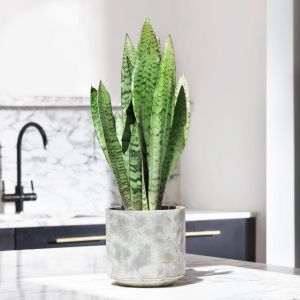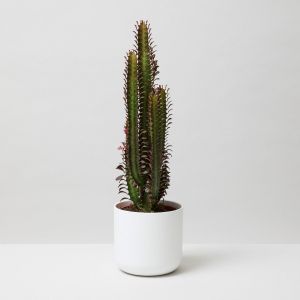Everything you need to know about how to look after a cactus or succulent
To make your plant parenting easy and really get the most out of your cactus or succulent, we’ve put together this blog on how to look after them. As long as you follow these simple steps on how to look after a cactus, caring for them will be a breeze. But before we go into our tips, here are some of our favourite, easy-care cacti and succulent indoor plants.
Popular low-maintenance cacti and succulents
Succulents come in a huge variety of shapes and sizes, making them extremely popular houseplants. Large succulents can be used as architectural, centre-pieces in living rooms or kitchens, whilst smaller varieties make great ornamental pieces on windowsills, coffee tables and desks. Here are three of our favourites:

The snake plant zeylanica, or Sansevieria ‘zeylanica’ is one of the hardiest indoor plants around. It has a distinct sword shape, succulent leaves with a zebra-like pattern. It’s the perfect houseplant for beginners or for stress-free plant parenting.

The bunny ear cactus, also called prickly pear, polka dot cactus or angel's wing, is a small variety of cactus that has paddle-shaped stems, shaped like bunny ears. It would make a great desk buddy or on a windowsill.

The African milk tree, or Euphorbia trigona, is a unique looking succulent native to tropical Africa where it is often grown into hedges. It has vibrant, red leaves that run all along its rigid green spine and would make a great centrepiece in a living room or kitchen. The African milk tree is also very easy to look after.
Four tips for how to look after a cactus or succulent
It is important to try and recreate the natural habitat of your cacti and succulents. To help you grow healthy and happy cacti and succulents, here are our four tips of how to look after them:
1. Place in a dry, well-lit position
Most succulents and nearly all cacti are sun-worshippers and need direct light to thrive. Although some succulents are found naturally in shadier spots (like all snake plant varieties), in general cacti and succulents are best kept in a spot that will get plenty of natural light- like on a windowsill or near a window.
Because of their water-storing abilities succulents and cacti tend to enjoy dry air. They may not do as well in a bathroom, for example. And they won’t require the extra humidity other tropical plants enjoy from misting or a humidifier.
2. Don’t overwater
Often found in deserts, succulents, and particularly cacti, are drought resistant. This means they require infrequent watering and won’t mind if you leave them parched occasionally. To avoid root rot let their soil completely dry out between watering and be particularly careful not to overdo it in the cooler months.
Despite a common misconception when it is time to water, succulents and cacti should be given a good soaking. When watering it’s a good idea to place them in a sink or outside so you can allow any excess water to drain away.
“
Often found in deserts, succulents, and particularly cacti, are drought resistant. This means they require infrequent watering and won’t mind if you leave them parched occasionally.
3. Plant in fast-draining soil
One way to avoid root-rot is to ensure your cacti and succulents are planted in fast-draining soil. You can purchase soil made specifically for cacti and succulents or modify regular houseplant compost by adding a nonorganic material - like grit.
It is also important to plant your succulents in a pot with drainage holes so their roots don’t sit in water.
4. Feed during summer
Cacti and succulents will benefit from being fed with fertiliser during summer. Opt for an organic indoor plant liquid fertiliser diluted with water and used no more than once per month. In autumn and spring stop fertilising completely.
Now you have learn about how to look after cactus, shop the Range Today
Have you seen our video? Watch our bite-sized video on how to look after your cacti and succulents.